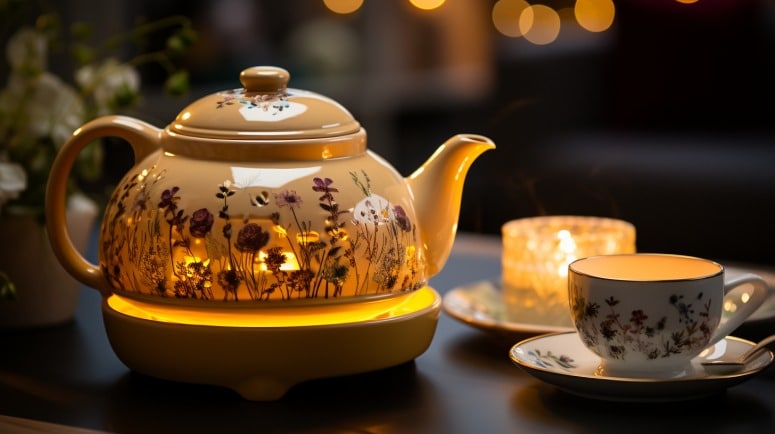Ah, chai tea! Just the mention of it makes my taste buds tingle with anticipation. This delightful beverage has grown immensely popular in recent years, captivating tea enthusiasts around the world. But what exactly is this magical elixir? In this article, we will take a deep dive into the mesmerizing flavors, origins, benefits, and the art of making the perfect cup of chai. Chai tea, a beloved beverage originating from India, has captured the hearts of tea enthusiasts worldwide.
From its aromatic blend of spices to its comforting and invigorating qualities, chai tea offers a delightful experience that soothes the senses and brings people together. So, join us as we explore the wonders of chai tea and unravel its secrets to crafting a truly delightful brew.
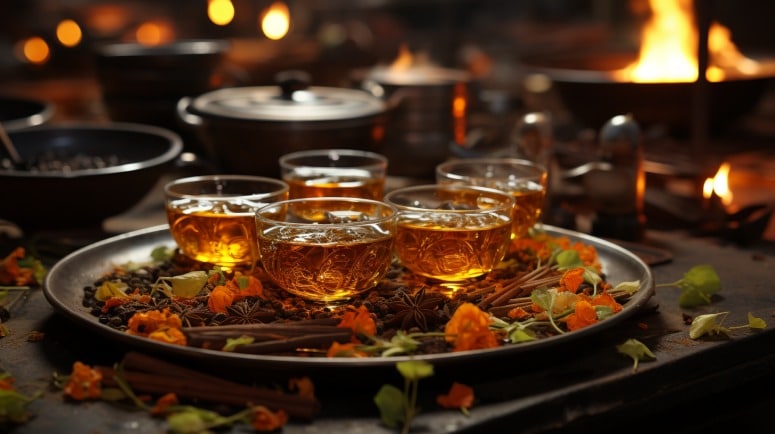
Table of Contents
What is Chai?
Chai tea is a unique and flavorful beverage that has its roots in India. This delightful concoction is typically made by combining black tea with a blend of aromatic spices. The key spices used in chai tea include cinnamon, cardamom, ginger, and cloves. These spices infuse the tea with their warm and earthy flavors, creating a rich and indulgent experience.
Chai tea is known for its comforting and invigorating qualities, making it a popular choice for tea lovers seeking a cozy and aromatic beverage. Its complex flavor profile combines the robustness of black tea with the subtle sweetness and warmth of the spices. The result is a harmonious blend that tantalizes the taste buds and creates a truly delightful tea-drinking experience.
Chai tea can be enjoyed in various ways, whether hot or iced, with milk or without. Its versatility allows for personalization, making it a truly customizable drink to suit different preferences. Whether you’re sipping it on a chilly winter morning or enjoying it as an afternoon pick-me-up, chai tea is sure to bring comfort and satisfaction with every sip.

Tasting Chai
When it comes to tasting chai tea, you can expect a delightful combination of flavors that dance on your palate. The unique blend of spices in chai tea creates a harmonious symphony of taste and aroma.
Cinnamon
One of the primary spices in chai tea is cinnamon, which adds a warm and slightly sweet element to the brew. Its distinct flavor enhances the overall richness of the tea.
Cardamom
Cardamom is another essential spice that contributes a subtle, floral note to the chai, elevating its complexity.
Ginger
Ginger, known for its invigorating properties, adds a subtle heat and a zingy kick to the blend. This spice adds a refreshing element to the tea and gives it a unique character.
Cloves
Cloves bring in a hint of earthiness and contribute to the warm and comforting aspects of chai tea.
Black Tea
When it comes to the tea itself, black tea is typically used as the base for chai. It provides a robust and malty flavor that holds up well against the boldness of the spices.
As for its caffeine content, chai tea does contain caffeine due to the inclusion of black tea. However, the exact amount can vary depending on the brew and dilution. If you prefer a milder caffeine kick, opt for green tea-based chai or choose to have it with less tea concentrate.
In a nutshell, chai tea offers a delightful balance of flavors, ranging from sweet and spicy to malty and robust. It’s a tea that awakens the senses and brings a sense of warmth and comfort with every sip.
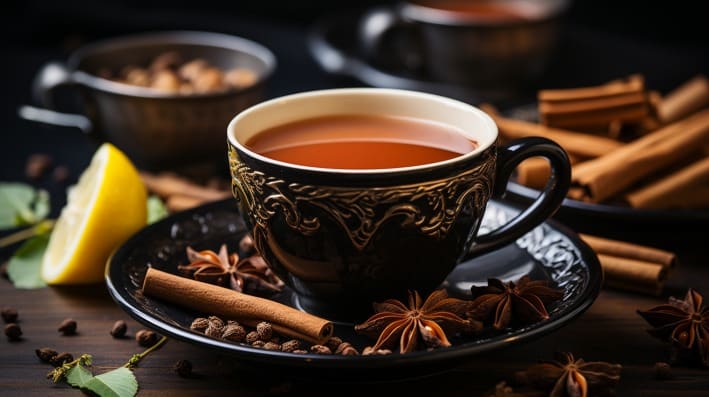
Preparing Chai
Now that we’ve explored the flavors of chai tea, let’s dive into the art of preparing this delightful beverage. While there are various ways to make chai, we’ll focus on a traditional stovetop method that allows the spices to infuse the tea fully.
To start, gather your ingredients: black tea leaves (or tea bags), water, milk, sugar (optional), and a selection of spices like cardamom pods, cinnamon sticks, ginger slices, and cloves.
In a saucepan, add water and bring it to a boil.
Once the water reaches a boil, reduce the heat to medium-low, and add the spices. Allow them to simmer gently for about 5 minutes. This step allows the flavors of the spices to infuse into the water.
Add the black tea leaves (or tea bags) to the saucepan, and simmer for an additional 2-3 minutes, allowing the tea to steep.
Stir in milk to the desired level of creaminess. Whole milk or plant-based milk like almond or soy can be used depending on personal preference.
Add sugar or a sweetener of choice if desired. Adjust the sweetness level to your liking.
Allow the chai to simmer for another 2-3 minutes, ensuring it doesn’t come to a rolling boil.
Strain the chai into cups or a teapot, discarding the spices and tea leaves.
Serve hot and enjoy the enchanting flavors of your homemade chai.
Remember, the key to a perfect cup of chai is finding the right balance between the spices, tea, milk, and sweetener. Feel free to adjust the proportions to suit your taste preferences.
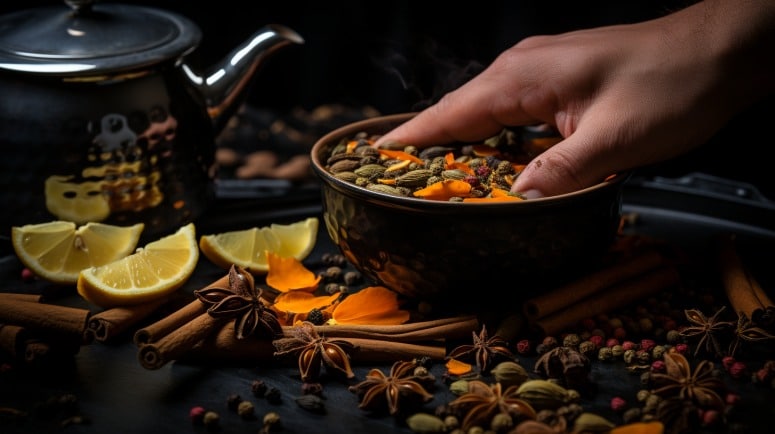
Buying and Storing Chai
Now that you know how to make chai at home, let’s explore how to choose and store chai tea for future brewing adventures. When it comes to buying chai, you have a few options:
Pre-made Chai Tea Bags: These convenient tea bags are readily available in most grocery stores. They contain a pre-mixed blend of black tea and spices, making it easy to brew a quick cup of chai.
Loose-Leaf Chai: For a more authentic and customizable experience, opt for loose-leaf chai. This allows you to have control over the amount of tea and spices used. Look for high-quality loose-leaf chai teas that contain whole, intact spices and fresh tea leaves.
When storing chai tea, it’s important to protect it from moisture, light, and strong odors to maintain its freshness. Here are some tips:
Use Airtight Containers: Transfer your loose-leaf chai or unopened chai tea bags to airtight containers like glass jars or tin containers. This helps to preserve the flavors and aromas.
Keep Away From Moisture: Ensure that your chai tea is stored in a cool, dry place away from any moisture or humidity. Avoid storing it near the stove or in the refrigerator, as exposure to moisture can degrade the tea’s quality.
Avoid Direct Sunlight: UV rays from direct sunlight can deteriorate the flavors of chai tea over time. Store your chai tea in a dark, shaded area to maintain its taste and aroma.
Consume within a Reasonable Timeframe: While chai tea generally has a longer shelf life compared to delicate green teas, it’s still best to consume it within a year of purchase for optimal freshness and flavor.
By following these guidelines, you can ensure that your chai tea remains flavorful and enjoyable for an extended period, providing you with the delightful chai experience you crave.
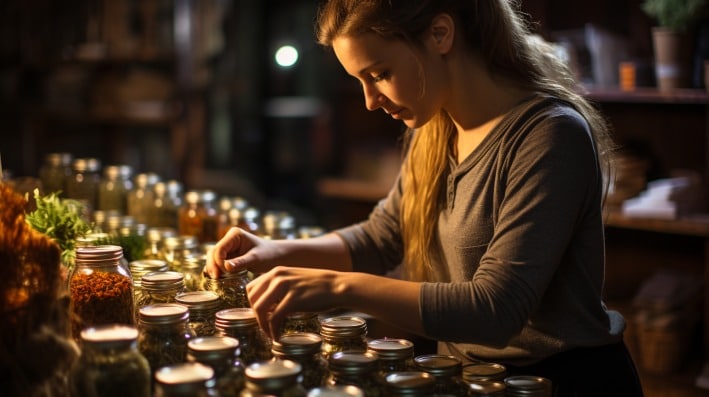
Chai vs Masala Chai
As chai tea has gained popularity, you may have come across the term “masala chai.” While often used interchangeably, there are subtle differences between chai and masala chai.
Chai
When we refer to “chai,” we are generally talking about the basic blend of black tea and spices. Chai originated in India and has been enjoyed for centuries. It typically consists of black tea leaves, cinnamon, cardamom, ginger, and cloves. This blend creates a warm and comforting beverage with a rich flavor.
Masala Chai
Masala chai, on the other hand, takes chai to the next level by adding additional ingredients into the mix. “Masala” refers to a mixture of spices, and in the context of masala chai, this usually includes the traditional chai spices along with other flavorful additions such as star anise, fennel seeds, nutmeg, or black pepper. These extra spices enhance the complexity and depth of the flavor profile, giving masala chai a more intense and spicier taste compared to regular chai.
In summary, chai is the base blend of black tea and spices, while masala chai refers to a spiced tea blend that goes beyond the traditional ingredients. Both chai and masala chai offer a delightful array of flavors, providing a comforting and aromatic tea-drinking experience.
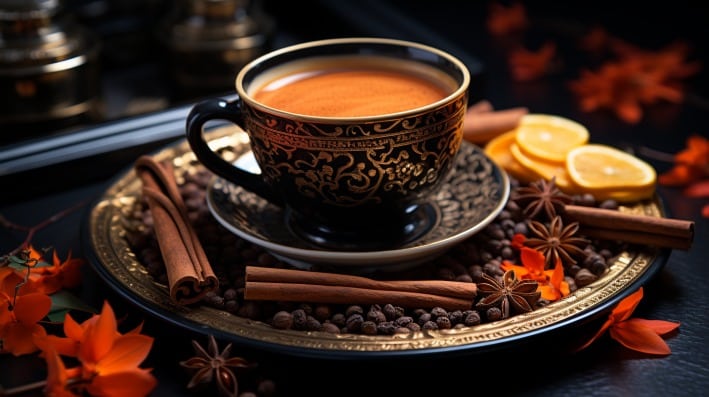
Potential Health Benefits of Chai Tea
Beyond its tantalizing flavors, chai tea also offers potential health benefits that make it even more appealing. Here are a few reasons to enjoy chai tea as part of a balanced lifestyle:
Antioxidant Rich: Chai tea contains several spices that are known for their antioxidant properties. Antioxidants help combat free radicals in the body, potentially reducing the risk of chronic diseases.
Digestive Aid: Many of the spices found in chai tea, such as ginger and cinnamon, have been used in traditional medicine to support digestion. They may help soothe an upset stomach, alleviate discomfort, and aid in digestion.
Potential Anti-Inflammatory Effects: Some of the spices in chai tea, like ginger and cloves, are believed to have anti-inflammatory properties. This may help reduce inflammation in the body and support overall well-being.
Boosts Immunity: The combination of spices in chai tea, including cardamom and cloves, is often associated with immune-boosting properties. They may help strengthen the immune system and defend against common illnesses.
Mood Enhancement: Chai tea’s warm and comforting characteristics have been known to uplift the mood and promote relaxation. It can be a soothing beverage to enjoy during moments of stress or as a cozy evening treat.
While chai tea offers potential health benefits, it’s important to note that individual results may vary. It’s always recommended to consume chai tea in moderation as part of a healthy, balanced diet.

How to Make a Chai Latte
If you enjoy the creamy and indulgent taste of a chai latte, you’ll be delighted to know that you can easily recreate this beverage at home. Here’s a step-by-step guide to making a delicious chai latte:
Ingredients:
1 cup of water
2 teaspoons of loose-leaf chai tea or 1 chai tea bag
1 cup of milk (dairy or plant-based)
Sweetener of choice (such as honey or sugar)
Whipped cream and ground cinnamon (optional, for garnish)
Instructions:
In a small saucepan, bring the water to a boil.
Add the loose-leaf chai tea or tea bag to the saucepan and simmer for 3-5 minutes, allowing the flavors to infuse. If using loose-leaf chai, you can strain the mixture afterward to remove the tea leaves.
Remove the saucepan from the heat and add milk to the brewed chai tea. Return the saucepan to low heat and warm the mixture, stirring occasionally, until it reaches your desired temperature.
Sweeten the chai latte with your preferred sweetener, adjusting the amount to taste.
Once heated and sweetened, carefully pour the chai latte into a mug.
For an extra touch of indulgence, top your chai latte with whipped cream and a sprinkle of ground cinnamon.
Serve hot and enjoy the comforting and creamy flavors of your homemade chai latte.
Feel free to customize your chai latte by adding a dash of vanilla extract, a pinch of nutmeg, or a drizzle of caramel syrup for added flavor. Get creative and make it your own!

Homemade Chai Tea Latte Recipe
If you’re looking for a specific recipe to follow for a delectable chai tea latte, here’s a tried-and-true method to achieve a perfect balance of flavors and a creamy texture:
Ingredients:
1 cup of water
2 teaspoons of loose-leaf chai tea or 1 chai tea bag
1 cup of milk (dairy or plant-based)
1 tablespoon of sweetener (such as honey or maple syrup)
1/2 teaspoon of vanilla extract (optional)
Ground cinnamon or nutmeg, for garnish (optional)
Instructions:
In a small saucepan, bring the water to a boil.
Add the loose-leaf chai tea or tea bag to the saucepan and simmer for 3-5 minutes, infusing the flavors into the water. If using loose-leaf chai, strain the mixture to remove the tea leaves.
Return the infused chai tea to the saucepan and add milk.
Heat the chai tea and milk mixture on low heat, stirring occasionally, until it reaches a gentle simmer. Be careful not to bring it to a rolling boil.
Stir in the sweetener of your choice, adjusting the amount based on your preference for sweetness.
If desired, add vanilla extract for an extra layer of flavor and stir well.
Once heated and well combined, carefully pour the chai tea latte into your favorite mug.
Sprinkle the top of the latte with a pinch of ground cinnamon or nutmeg for a touch of spice.
Take a moment to savor the aroma and indulge in the creamy, spiced goodness of your homemade chai tea latte.
Feel free to experiment with different milk alternatives, spices, or sweeteners to create your ideal chai tea latte. You can even top it off with frothed milk or a dollop of whipped cream for an extra luxurious treat.
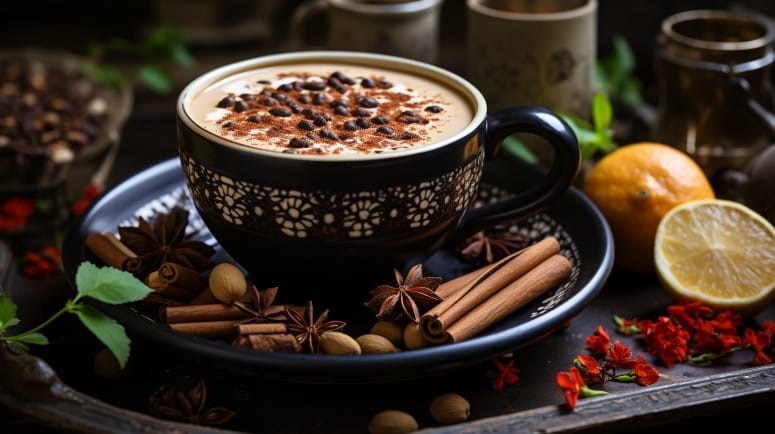
Conclusion
The world of chai tea is a diverse and vibrant one, offering a plethora of options to suit every taste and preference. Whether you prefer the classic combination of black tea and spices, or you like to explore unique variations like adding fresh ginger or using different types of milk, there is a chai recipe out there waiting to be discovered. From traditional loose leaf black tea blends to convenient tea bags, the possibilities for making chai are endless.
Experiment with various spices like cinnamon sticks, whole cloves, or black peppercorns to create your own signature chai blend. Don’t forget to sweeten your chai with your preferred choice of sugar or sweetener, whether it’s brown sugar, unrefined cane sugar, or coconut sugar. Whatever method and ingredients you choose, brewing a warm cup of chai or a refreshing iced chai latte will surely transport you to a cozy coffee shop, all in the comfort of your own home.
So, don’t hesitate to immerse yourself in the enticing world of chai and discover the best chai recipe that suits your taste buds. Keep your ingredients stored in an airtight container to ensure they stay fresh for future indulgent moments. Whether you enjoy it with baked goods or simply on its own, chai tea is a delightful beverage that brings warmth and comfort to any occasion. Cheers to the soothing and flavorful world of chai tea!
What are some alternative milk options that can be used in chai lattes instead of dairy milk?
If you prefer non-dairy alternatives, there are several options to consider. Coconut milk, almond milk, oat milk, and even a combination of these can be used as substitutes for dairy milk in chai lattes. These plant-based milks offer a creamy texture and can complement the flavors of chai beautifully. Simply replace the milk called for in the recipe with your favorite milk alternative to enjoy a delicious and dairy-free chai latte.
Are there any specific chai recipes that use loose leaf tea instead of tea bags?
Absolutely! Using loose leaf tea is a fantastic way to enhance the flavor and authenticity of your chai. In a medium saucepan, bring water to a boil, then add your desired amount of loose leaf tea. For a basic chai, you can use Darjeeling tea or English Breakfast tea. Add in spices like cinnamon sticks, dried ginger, and whole cloves. Let it steep for a few minutes on medium heat before straining the tea. To make it even more indulgent, add your favorite milk and sweetener, and simmer until heated through. This loose leaf chai recipe will allow you to savor the delicate flavors of the tea and spices.
Can I make chai without an immersion blender or a vigorously whisking technique?
Yes, you can make chai without an immersion blender or vigorously whisking. While some recipes suggest using these methods to froth the milk, they are not essential for a delicious chai. To create a delightful chai latte at home, simply heat your milk of choice in a small saucepan until warm. Then add your brewed chai tea, spices, and sweetener. Stir well to combine all the flavors and allow them to meld together. If desired, you can use a basic whisk or simply pour the chai into a lidded container and shake vigorously to mix the milk and tea. The result will still be a delightful chai latte without the need for specialized equipment or excessive whisking.
What are some other spices I can add to my chai to create unique flavor profiles?
In addition to the classic spices like cinnamon sticks and ginger, adding other spices can introduce exciting flavor variations to your chai recipe. Consider experimenting with cardamom pods for a floral note, black peppercorns for a touch of heat, or star anise for a subtle licorice flavor. Nutmeg and cloves can add warm, aromatic undertones, while a pinch of saffron can bring a hint of exotic flair. Feel free to adjust the spice quantities to suit your taste preferences. The beauty of making chai at home is the opportunity to customize the blend and explore your favorite flavor combinations. Remember, always start with small amounts of the additional spices and gradually increase them to achieve your desired flavor profile. By incorporating different spices into your chai recipe, you can create an endless array of unique and delightful flavor experiences. Don’t be afraid to get creative and make your chai truly one-of-a-kind.


